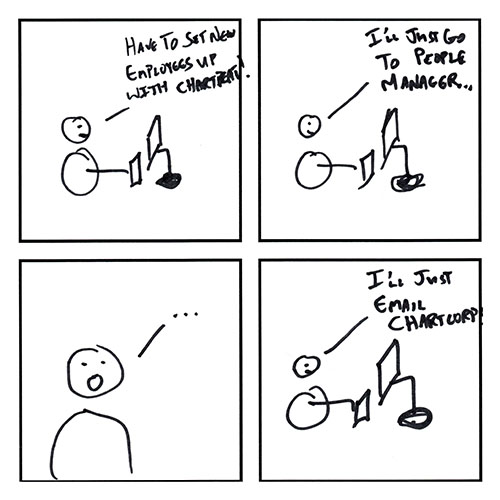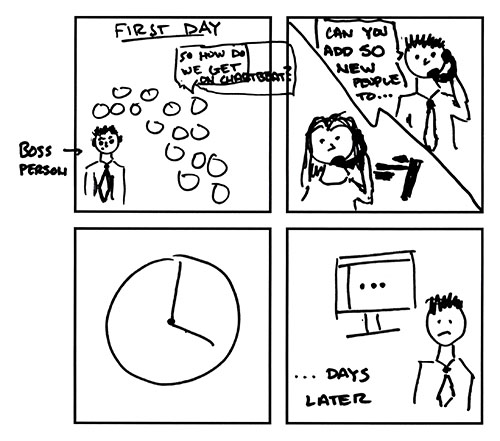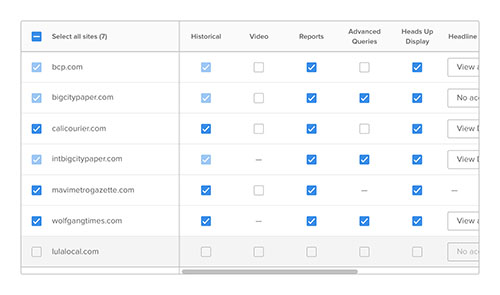Authors: Jess Phoa
Posted: Wed, December 11, 2019 - 2:28:51
I’ve always loved expressing myself through visual means for as long as I can remember: When I was a kid, I created art with reckless abandon. I didn’t care what others thought about what I made—I drew simply because I wanted to. Never would my younger self have imagined that my love for drawing would eventually help me with my future career.
I’ve found that sketching—when put to use in the workplace—can be an integral part of the design process, grounding an entire team in the user problems they aim to solve.
I’ve seen this process succeed firsthand in my work at Chartbeat, a technology company that provides data and analytics to global publishers. But the takeaways can be applied to any workplace or academic setting where people collaborate to solve user problems.
Creating a memorable end user via sketching
Shortly after I joined Chartbeat, I was assigned to the admin tools product team consisting of myself along with several front-end and back-end engineers and a product manager. We were tasked with making our product’s user management workflow scale better to accommodate organizations of all sizes. At the time, admins’ workflows for managing new and current users were manual and time-consuming, and certain processes even required assistance from our in-house support team.
Our goal was to reduce friction in the onboarding experience for our end users and free up time spent by our internal support teams.

Christina and Hugo, our imaginary users.
I wanted to make sure we remained mindful of the users we were serving, so I drew up Christina and Hugo, fictional, prototypical users. Christina and Hugo have since become key members of our team and are often referenced in product meetings and discussions.
Building empathy for user problems
To help better understand the problems at hand that real users encountered, I also got the whole team involved in drawing.
I use the term “drawing” loosely here because “knowing how to draw” can sound intimidating. The goal for these sketching sessions was not to produce beautiful illustrations, but rather to build empathy for the people we were designing for. Sketching is a hands-on, approachable way to ground a team in a problem, let everyone contribute to the ideation process, and take a break from our screens.
Often, our sketches are more rudimentary—focused on expressing the emotions and mentality of users that we are serving.
For this session, I provided participants with paper templates containing blank squares and gave them five minutes to draw a comic about the then current state of the user management workflow. What I love about this exercise is how the open-endedness of the prompt lends itself to various interpretations, thus different perspectives.


Drawings created by my coworkers for a participatory sketch exercise I facilitated.
These sorts of sketches prompt team members to put themselves in the end user’s shoes and evaluate the larger context of where and how these problems emerge.
Generating ideas from the whole team
Sometimes, our sketching sessions were focused on ideas for how our user experience could solve those problems.
No matter their background, every member of our team could take a few minutes to sketch an idea for a potential user experience. And each sketch brought a valuable idea to the table. In fact, our team’s front-end engineer drew the first sketch that eventually became our revamped user interface for granting user permissions within our product suite.
”Sketching is an invaluable part of how we work through problems as a team,” says Kris Harbold, a product manager. “By having everyone, including engineers, put their ideas on paper, we open up space for conversations on not just how to best address our users’ problems, but also how they might feel about the experience and potential trade-offs. It encourages team alignment and gives people a sense of ownership of the final release.”

Permissions provisioning sketch by my teammate created during a group brainstorm.
Of course, sketches can only take a team so far. Once we had a sketch that seemed promising, I wanted to collect user feedback, so I collaborated with the same front-end engineer on a rough, clickable prototype. I conducted rapid internal user testing with a handful of my colleagues, including those who regularly fielded questions from clients around user management.
Their feedback, along with beta feedback from users and eventual results from our general release, validated that our updated user permissions provisioning workflow was a drastic improvement. The real-life versions of our fictitious admins Christina and Hugo could handle more tasks on their own, and with less effort.

Screenshot of the redesigned user permissions widget.
Sketching has undoubtedly become one of the most accessible design research methods in my toolkit, and I’ve seen firsthand how it can energize a team around a user problem. Next time you find yourself starting a project and you’re not sure where to start, see where drawing takes you!
Further reading
Learn how to run a sketch session
The potential of participatory design
How to run quick usability tests
Posted in: on Wed, December 11, 2019 - 2:28:51
Jess Phoa
View All Jess Phoa's Posts







Post Comment
@Okeke Frances-nora (2023 11 28)
An amazing and informative write up.
Weldone Jessica
@Amora Potter (2025 03 04)
When it comes to creating music, is it feasible to defy the rules? Sprunki Retake is your platform now, so do something truly spectacular!
@Drift Hunters (2025 03 05)
Perfect mix of speed and skill! I love Drift Hunters how much attention to detail they’ve put into the cars and the tracks.
@Helen Grace (2025 05 02)
Speed Stars is where raw speed meets fearless ambition. Every lap is a battle of nerves, precision, and instinct. This isn’t just racing — it’s survival of the fastest
@Helen Grace (2025 05 02)
Every turn in Speed Stars demands total focus. It’s not just about pushing the throttle — it’s about timing, tactics, and taming the track. Blink, and you’re left in the dust.
@Disegnidacoloraremondo (2025 05 15)
That’s a fascinating look at the role of sketching in product design! It reminds me of the joy of bringing even simple outlines to life with color. Speaking of which, for anyone who enjoys the creative process, you can find tons of fun disegni da colorare at Disegnidacoloraremondo.com. It’s a great way to unwind and explore your artistic side, no matter your design expertise!
@Basketball Bros (2025 06 11)
It’s amazing how creativity can bridge gaps in understanding user needs, right? Sketching isn’t just doodling; it’s a powerful tool to align a team around solutions and empathy. If you’re looking to inject some fun into your brainstorming, check out how playful activities can engage everyone by exploring something like https://basketballbros.me.
@doramasflix.to (2025 06 26)
I enjoy trying each one out and experiencing how uniquely they handle when drifting. doramasflix.to
@Ministitch (2025 08 20)
Shop stylish and trendy Western wear for girls online in India. Discover trendy outfits and accessories for every occasion. western wear for girls
@drive mad (2025 09 02)
Loved the post — thanks for sharing! Speaking of fun browser games, I recently stumbled across a wild driving game called Drive Mad. It’s a fast-paced physics-based game where you try to survive crazy obstacle courses without flipping your vehicle. Super addictive and surprisingly challenging!
You can play it for free here: https://drive-mad.run/
No sign-up or download needed — just pure driving chaos in your browser.
Great for quick breaks or if you just want something fun and frustrating in the best way possible!